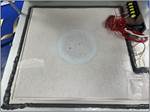Composite Integration adds real-time resin degassing measuring to Ciject equipment
Ciject resin infusion and injection machinery now offers real-time resin degassing measurement technology that uses sensors and software to continuously monitor the state of resin during the degassing process.
High quality achieved through the use of proper techniques. Source (All Images) | Composite Integration
Composite Integration (Saltash, U.K.) has unveiled a significant addition to its Ciject range of infusion and injection machinery: real-time resin degassing measurement technology. Ciject equipment is easy to use and enables high-quality parts production. This new functionality furthers its quality capabilities across critical sectors, including aerospace, wind energy and marine industries.
In environments where the precision and integrity of composite materials are crucial, knowing how well degassed a resin system is has seldom been well understood or measured. Recognizing this limitation, Composite Integration’s technology offers consistent and precise measurement and control of resin degassing. It uses advanced sensors and software to continuously monitor the state of resin during the degassing process. Integrated with real-time analytics, it can detect and quantify the presence of gases within the resin, enabling immediate adjustments. This ensures optimal resin quality throughout the infusion process, reducing the risk of defects and improving the overall integrity of the finished composite.
Typical data from a Ciject 5 can be seen after a period of degassing (top). Typical data from an epoxy resin sample in the lab which has been degassed and left to “age” or re-gas over time (bottom).
The opening image showcases resin-infused laminates with degassed resin, measuring using Composite Integration’s technology. Correctly degassed resins, constantly monitored and maintained by Ciject technology, produce laminates with negligible void content.
The Ciject range of resin infusion and injection machines are equipped with features such as remote access and designed with the user in mind. They are engineered for use in vacuum infusion, RTM and Direct Infusion processes, giving engineers ultimate control over resin quality, according to the company. Their straightforward usability further simplifies operation, resulting in few mistakes and a lower cost of ownership.
“Our latest development is a direct response to our customers’ demands for control and quality in composites manufacturing,,” says Tim Searle, R&D director at Composite Integration. “This technology is not just an enhancement; it’s a fundamental shift in how we ensure quality across multiple industries.”
Related Content
-
Pultrusion: The basics
A primer describing what pultrusion is, its advantages and disadvantages, and typical applications.
-
TU Munich develops cuboidal conformable tanks using carbon fiber composites for increased hydrogen storage
Flat tank enabling standard platform for BEV and FCEV uses thermoplastic and thermoset composites, overwrapped skeleton design in pursuit of 25% more H2 storage.
-
Plant tour: Joby Aviation, Marina, Calif., U.S.
As the advanced air mobility market begins to take shape, market leader Joby Aviation works to industrialize composites manufacturing for its first-generation, composites-intensive, all-electric air taxi.


















.jpg;maxWidth=300;quality=90)
